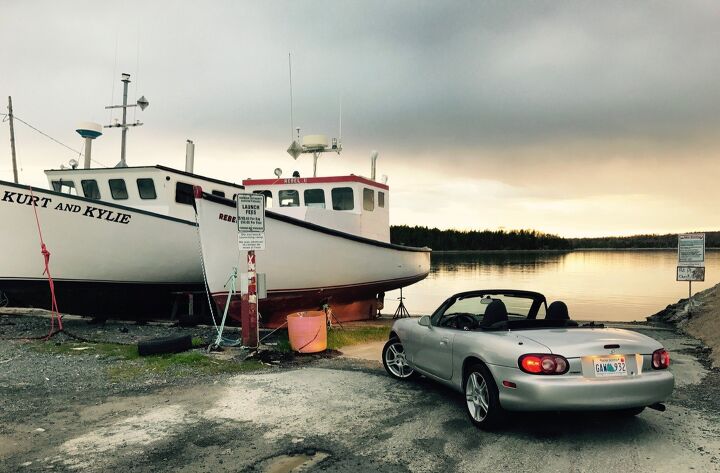Introducing Tim's Early-Life Crisis: 2004 Mazda MX-5 Miata Long-Term Test
Silver was not my first choice. But after spending weeks on the prowl for an older Mazda Miata, I found the right car within walking distance of my childhood home.
Our new-to-us Miata is a 2004 model with a six-speed manual and only 43,000 miles under its belt. Always stored for the winter, as most Miatas are in this part of eastern Canada, the car is in ridiculously good condition, revving seductively and shifting like nothing else shifts this side of an RX-8.
I’m not a huge fan of the MY2004-2005 OEM wheels. I’d prefer cloth seats. It’s silver, not the black I was after.
But after considering German droptops and Jeep Wranglers and numerous vehicles that did not come close to fulfilling my list of requirements, I couldn’t deny my initial instincts.
I wanted a Miata for 28 years. I have one now.
What caused me to avoid the other cars on the list we showed you earlier this week?
The Jeep Wrangler was let down on a few counts. First, tedious softtop operation, combined with hardtop removal, make it less of a spur-of-the-moment convertible. Pre-owned Wrangler prices are also exceptionally high. I’m moving to an area with some exceptionally fun roads, and while the Wrangler would’ve been a great winter companion in Prince Edward Island, it wouldn’t have been any fun on the undulating rural roads of central PEI.
The European convertibles, particularly the BMW 3 Series, are undeniably desirable. But I was frightened by long-term maintenance costs for German cars that often appeared tired and worn when I’d examine them in daylight. I’d have appreciated the power of a BMW inline-six, no doubt, but power isn’t really what I’m after. Moreover, the rate of depreciation for these cars — cars which other buyers likewise believe to be costly to maintain as they age — wasn’t encouraging.
I couldn’t help but consider other four-wheel-drive SUVs: GM brutes and oddballs like the Land Rover LR3 and Volkswagen Touareg. There was even a Hummer H3 Alpha that intrigued me. Then there were Minis and Golf GTIs, tuned Preludes and RSXs. But we weren’t looking for a second vehicle so much as we were looking for a financially sane convertible purchase. Mrs. Cain and I both work from home; vehicles in our possession rack up very little mileage.
If, for some reason, our new Miata must be sold in the coming months or years, it’ll be a car without much more mileage than it currently possesses, a car that was stored in the garage all winter, a car that will be more fastidiously maintained than our 2015 Honda Odyssey.
If the $7,500 USD price I paid concerns you, consider the fact that there were other Miatas — older and more costly Miatas — selling around the same time. (Canada’s average asking price for a 2004 MX-5 Miata GT is $8,800 USD.) Finding a Miata that wasn’t roughed up or ostentatiously modified wasn’t easy for me, nor will it be for the buyer who’s looking for a Miata when I’m selling mine.
Selling? Nah, I certainly don’t plan to. I love this car.
Although it’s heresy among Miataphiles, I’m actually not a huge fan of the NA’s look. The NC is a sweet little car, and I’m a big fan of the style, but I don’t find the driving experience as engaging. Obviously, the new MX-5 Miata — the ND — is a spectacular device, but it was far outside my price range. This leaves the NB, the 1999-2005 car with its 142-horsepower 1.8-liter four-cylinder and sub-2,500-pound curb weight and 28 mile per gallon highway efficiency.
The Miata heads to the Mazda dealer this afternoon for an oil change. I’ve already de-fogged the headlamps, brought the drainholes up to snuff, and cleaned the roof.
It’s not perfect. The 12v outlet doesn’t work. The floor mat attachment doesn’t stay firmly in place. A three-year-old boy has already left crumbs in the passenger seat.
It’s also silver.
That’s okay. I’ll survive.
[Images: © 2017 Timothy Cain]
Timothy Cain is the founder of GoodCarBadCar.net and a contributing analyst at The Truth About Cars and Autofocus.ca. Follow on Twitter @timcaincars.
More by Timothy Cain
Latest Car Reviews
Read moreLatest Product Reviews
Read moreRecent Comments
- Jalop1991 In a manner similar to PHEV being the correct answer, I declare RPVs to be the correct answer here.We're doing it with certain aircraft; why not with cars on the ground, using hardware and tools like Telsa's "FSD" or GM's "SuperCruise" as the base?Take the local Uber driver out of the car, and put him in a professional centralized environment from where he drives me around. The system and the individual car can have awareness as well as gates, but he's responsible for the driving.Put the tech into my car, and let me buy it as needed. I need someone else to drive me home; hit the button and voila, I've hired a driver for the moment. I don't want to drive 11 hours to my vacation spot; hire the remote pilot for that. When I get there, I have my car and he's still at his normal location, piloting cars for other people.The system would allow for driver rest period, like what's required for truckers, so I might end up with multiple people driving me to the coast. I don't care. And they don't have to be physically with me, therefore they can be way cheaper.Charge taxi-type per-mile rates. For long drives, offer per-trip rates. Offer subscriptions, including miles/hours. Whatever.(And for grins, dress the remote pilots all as Johnnie.)Start this out with big rigs. Take the trucker away from the long haul driving, and let him be there for emergencies and the short haul parts of the trip.And in a manner similar to PHEVs being discredited, I fully expect to be razzed for this brilliant idea (not unlike how Alan Kay wasn't recognized until many many years later for his Dynabook vision).
- B-BodyBuick84 Not afraid of AV's as I highly doubt they will ever be %100 viable for our roads. Stop-and-go downtown city or rush hour highway traffic? I can see that, but otherwise there's simply too many variables. Bad weather conditions, faded road lines or markings, reflective surfaces with glare, etc. There's also the issue of cultural norms. About a decade ago there was actually an online test called 'The Morality Machine' one could do online where you were in control of an AV and choose what action to take when a crash was inevitable. I think something like 2.5 million people across the world participated? For example, do you hit and most likely kill the elderly couple strolling across the crosswalk or crash the vehicle into a cement barrier and almost certainly cause the death of the vehicle occupants? What if it's a parent and child? In N. America 98% of people choose to hit the elderly couple and save themselves while in Asia, the exact opposite happened where 98% choose to hit the parent and child. Why? Cultural differences. Asia puts a lot of emphasis on respecting their elderly while N. America has a culture of 'save/ protect the children'. Are these AV's going to respect that culture? Is a VW Jetta or Buick Envision AV going to have different programming depending on whether it's sold in Canada or Taiwan? how's that going to effect legislation and legal battles when a crash inevitibly does happen? These are the true barriers to mass AV adoption, and in the 10 years since that test came out, there has been zero answers or progress on this matter. So no, I'm not afraid of AV's simply because with the exception of a few specific situations, most avenues are going to prove to be a dead-end for automakers.
- Mike Bradley Autonomous cars were developed in Silicon Valley. For new products there, the standard business plan is to put a barely-functioning product on the market right away and wait for the early-adopter customers to find the flaws. That's exactly what's happened. Detroit's plan is pretty much the opposite, but Detroit isn't developing this product. That's why dealers, for instance, haven't been trained in the cars.
- Dartman https://apnews.com/article/artificial-intelligence-fighter-jets-air-force-6a1100c96a73ca9b7f41cbd6a2753fdaAutonomous/Ai is here now. The question is implementation and acceptance.
- FreedMike If Dodge were smart - and I don't think they are - they'd spend their money refreshing and reworking the Durango (which I think is entering model year 3,221), versus going down the same "stuff 'em full of motor and give 'em cool new paint options" path. That's the approach they used with the Charger and Challenger, and both those models are dead. The Durango is still a strong product in a strong market; why not keep it fresher?



































Comments
Join the conversation
The answer is always Miata (unless you're over 6'1"). Good luck!
although i'm driving and loving driving a 2017 roadster, the nb model is still the best looking mx-5 made. so you have a winner, mr cain. may your roads always be twisting cuz that's the most fun.